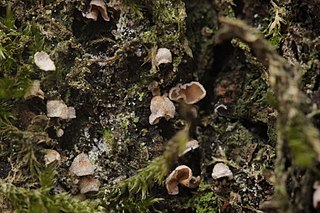
Sarcoscypha coccinea, commonly known as the scarlet elf cup, scarlet elf cap, or the scarlet cup, is a species of fungus in the family Sarcoscyphaceae of the order Pezizales. The fungus, widely distributed in the Northern Hemisphere, has been found in Africa, Asia, Europe, North and South America, and Australia. The type species of the genus Sarcoscypha, S. coccinea has been known by many names since its first appearance in the scientific literature in 1772. Phylogenetic analysis shows the species to be most closely related to other Sarcoscypha species that contain numerous small oil droplets in their spores, such as the North Atlantic island species S. macaronesica. Due to similar physical appearances and sometimes overlapping distributions, S. coccinea has often been confused with S. occidentalis, S. austriaca, and S. dudleyi.

Humaria hemisphaerica is a species of fungus in the family Pyronemataceae. In the UK it has the recommended English name of glazed cup; in North America it has been called the hairy fairy cup or the brown-haired fairy cup. Ascocarps are cup-shaped and can be recognized by their smooth, white inner surface and hairy, brown outer surface. The species is ectomycorrhizal and occurs in Europe and North America. The specific epithet is derived from the Latin word hemisphaericum, meaning half a sphere.

Sowerbyella is a genus of fungi in the family Pyronemataceae. The genus has a widespread distribution, and contains 17 species found mostly in Europe and China.

Urnula craterium is a species of cup fungus in the family Sarcosomataceae. It is parasitic on oak and various other hardwood species; it is also saprobic, as the fruit bodies develop on dead wood after it has fallen to the ground. Appearing in early spring, its distinctive goblet-shaped and dark-colored fruit bodies have earned it the common names devil's urn and the gray urn. The distribution of U. craterium includes eastern North America, Europe, and Asia. It produces bioactive compounds that can inhibit the growth of other fungi. The asexual (imperfect), or conidial stage of U. craterium is a plant pathogen known as Conoplea globosa, which causes a canker disease of oak and several other hardwood tree species.

Urnula is a genus of cup fungi in the family Sarcosomataceae, circumscribed by Elias Magnus Fries in 1849. The genus contains several species found in Asia, Europe, Greenland, and North America. Sarcosomataceae fungi produce dark-colored, shallow to deep funnel-shaped fruitbodies with or without a stipe, growing in spring. The type species of the genus is Urnula craterium, commonly known as the devil's urn or the gray urn. Urnula species can grow as saprobes or parasites having an anamorphic state. The anamorphic form of U. craterium causes Strumella canker, on oak trees.

Pyramidella is a genus of minute to medium-sized sea snails, marine gastropod mollusk in the subfamily Pyramidellinae of the family Pyramidellidae, the pyrams and their allies.

Naquetia is a genus of medium-sized sea snails, marine gastropod mollusks in the family Muricidae, the rock snails or murex snails.
Ilyanassa is a genus of sea snails, marine gastropod mollusks in the family Nassariidae, the Nassa mud snails or dog whelks.

Purpura is a genus of sea snails, marine gastropod mollusks in the subfamily Rapaninae of the family Muricidae, the murex snails or rock snails.

Thiara is a genus of freshwater snails, aquatic gastropod mollusks in the subfamily Thiarinae of the family Thiaridae.

Nectria peziza or yellow spot is an ascomycete fungus with bright yellow to orange globose fruiting bodies found on rotting polypores, well rotted deadwood, bark, dung, and decaying cloth. Its globular fruiting bodies (peritheca), quite large for the genus, may be isolated or crowded; they have a slightly prominent black dot at the top, the ostiolum, this being the entrance to the inner cavity; the bodies often collapse into a cup-shape when dry and the colour fades to pale yellow or whitish.

Tricholoma aestuans is a mushroom of the agaric genus Tricholoma. First described formally by Elias Magnus Fries in 1821, it was transferred to the genus Tricholoma by Claude Casimir Gillet in 1874.

Leucocoprinus cretaceus is a species of mushroom producing fungus in the family Agaricaceae. It is likely tropical in origin although it was first documented in Europe where it was often found growing in greenhouses and bark beds. However many early observations conflate this species with Leucocoprinus birnbaumii or Leucocoprinus cepistipes despite sharing only some superficial similarities. This fungus is quite versatile even for a saprotroph and is often found growing in clusters on woodchips, sawdust and compost heaps as well as directly from the ground or on trees. It may also appear in plant pots and greenhouses in colder countries in which it is not well equipped to survive outside.

Auricularia nigricans is a species of fungus in the family Auriculariaceae. Basidiocarps (fruitbodies} are gelatinous, ear-like, and grow on dead wood of broadleaf trees. It is an American species, known from Louisiana and the Caribbean south to Argentina, and was formerly confused with the similar Asian species Auricularia polytricha, originally described from India.
Acinula is a monotypic genus of fungus with unknown classification. The only species is Acinula candicans.

Chromocyphella muscicola is a species of fungus in the family Hymenogastraceae. Basidiocarps are cyphelloid, cup-shaped, about 4 mm across, with an upper surface covered with fine hairs and a smooth underside.

Fumago is a genus of fungi belonging to the family Capnodiaceae.

Pandora is a genus of small saltwater clams, marine bivalves in the family Pandoridae.

Cookeina speciosa is a species of fungus in the family Sarcoscyphaceae.
















